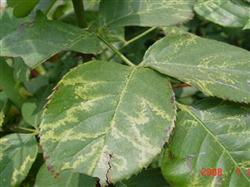Grey mildew of rose

Symptoms: rose gray mold in the leaf margin and leaf tip occurs, initially for water-like pale brown spots, smooth slightly sunken, after the expansion of decay. Bud disease, gray spots black, can prevent a flower opening, disease bud brown dead. When the flower is attacked, some petals turn brown, shrivel and rot. Botrytis cinerea also infects the tips of branches after flower folding, and black diseased parts can be up to several centimeters below the infection point. In warm and humid conditions, the gray mold layer can completely cover the infected site. Pathogen: Botrytis cinerea Pers, a fungus belonging to the class Trichosporales. Transmission route: overwintering with mycelium or sclerotia, producing conidia in the second year, spreading by wind and rain, invading from wound or directly invading from epidermis. Greenhouse month humidity, easy to occur gray mold. When the withered flowers and pedicels are not removed in time, the disease often spreads first from such decaying tissues and then to healthy flowers and buds. Control methods 1. Timely removal of disease, reduce infection sources, for withered roses should also be promptly cut off. 2. Greenhouse should be properly ventilated, not too large temperature difference between day and night, humidity is too high, there should be appropriate space between each rose basin. When watering, pour in from the edge of the pot, do not let the leaves and flowers retain water. Cut flowers on a sunny day heal wounds easily. 3. At the beginning of disease control, spray protection, when using 1:1:100 times Bordeaux mixture, spray once every two weeks. 4. Spray method: spray 2000 times solution of 50% procystin wettable powder, or 1000~1500 times solution of 50% iprohydantoin wettable powder, or 500 times solution of 50% thiophanate-methyl wettable powder, or 500 times solution of 50% carbendazim, or 500 times solution of 70% mancozeb once every 7~10 days for 2~3 consecutive times, and the amount of liquid medicine sprayed every 67m2 shall not be less than 50~60 kg. The preventive effect of the above agents is better than the therapeutic effect, and attention should be paid to alternating the use of agents to prevent drug resistance. In greenhouse cultivation of roses, the following application methods can also be tried: 1. Smoke method: 10% Sukeling smoke agent every 667 m2 200 ~250 g, or 45% chlorothalonil smoke agent every 667 m2 250 g, fumigation for 3~4 hours. 2. Dust method: 10% laike dust or 5% chlorothalonil dust or 10% mirex dust can also be sprayed in the evening, every 667m2 kg, once every 9~11 days, continuously used or other control methods alternately used 2~3 times.
- Prev

Hanging cultivation techniques of Lentinus edodes in winter
If the scientific inoculation hole is deep, there are more bacteria, which is helpful to enhance the drought resistance of Lentinus edodes mycelium. The mycelium of Lentinus edodes can germinate rapidly and improve the survival rate under the condition of constant temperature and humidity. Hot water buds are accelerated by soaking blocks in hot water, which can double the yield of mushroom pieces.
- Next

Prevention and treatment of rose mosaic disease
Rose mosaic disease is widely distributed, which can cause the decline of the yield and quality of cut rose flowers. Symptoms: the symptoms vary from rose to rose. Rose mosaic virus is characterized by small green spots, sometimes showing polygonal patterns. The leaf surface around the lesion is often more or less deformed. Some of the symptoms are circular.
Related
- Fuxing push coffee new agricultural production and marketing class: lack of small-scale processing plants
- Jujube rice field leisure farm deep ploughing Yilan for five years to create a space for organic food and play
- Nongyu Farm-A trial of organic papaya for brave women with advanced technology
- Four points for attention in the prevention and control of diseases and insect pests of edible fungi
- How to add nutrient solution to Edible Fungi
- Is there any good way to control edible fungus mites?
- Open Inoculation Technology of Edible Fungi
- Is there any clever way to use fertilizer for edible fungus in winter?
- What agents are used to kill the pathogens of edible fungi in the mushroom shed?
- Rapid drying of Edible Fungi

